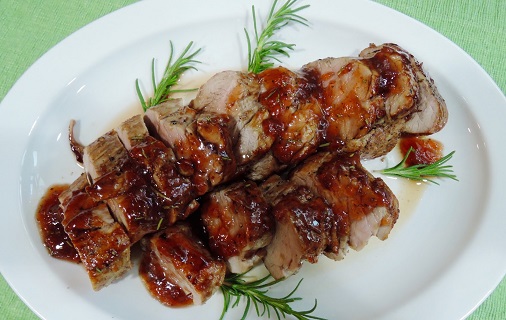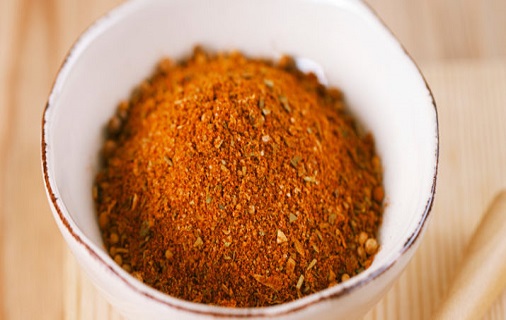This pork tenderloin recipe is a hit because of its juicy, soft inside and deliciously crunchy crust, all encased in a flavorful garlic butter. The pork meal is incredibly juicy and tender, almost like the best piece of meat you’ve ever tasted. This soft flesh is surrounded by a thin, slightly crunchy crust. It has a tiny crunch when you bite into it, which makes eating enjoyable.
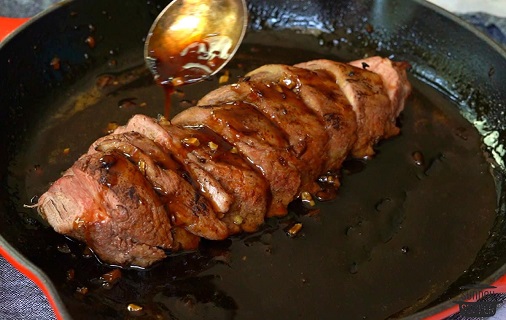
However, the crispy component serves more purposes than merely texture. It’s buttery and garlicky, which enhances the flavor of the pork. It’s the perfect amount of strength, making every bite delicious. It sounds elegant, but it takes less than 40 minutes to prepare. It’s ideal for those occasions when you want to eat something delicious and feel good about it. It resembles a delight that is extremely simple to prepare! An easy baked pork tenderloin has always been one of my favorite simple recipes; it’s tasty, rich, and hearty, and it’s so easy to make.
If you’ve never cooked pork before, this is an excellent pork tenderloin recipe to try because it’s easy enough for even inexperienced home cooks to make, but the flavor is robust enough to satisfy even the most expert chefs!
You’ll Need Items
- Pork Tenderloin: A really succulent and juicy cut of pork that cooks up perfectly moist and flavorful. If tenderloin is unavailable, consider substituting pork loin or pork chops. Even though they might require a bit more attention to stay juicy, they can still come out delicious.
- Butter adds richness and flavor when baking and cooking. If you’d rather, you can replace it with margarine or olive oil. Although they won’t taste exactly alike, they will nevertheless provide a pleasant flavor.
- Herbs or Italian seasoning: You can substitute or add to the herbs called for in your recipe if your Italian seasoning comprises herbs like dried thyme, oregano, and rosemary. To enhance the pork tenderloin’s delectable Italian characteristics, simply rub or sprinkle the Italian seasoning on it before cooking.
- Salt and black pepper: Practically all recipes use salt and pepper as basic seasonings to intensify flavors. For something a little bit different, you may try using seasoned salt or other peppers, such as white or black pepper.
- Garlic gives food a powerful, mouthwatering flavor. If you are lacking fresh garlic, you can substitute it with garlic powder or paste. They are simpler to use, yet they have a similar flavor.
- Spices: Try adding some smoky paprika and chili powder to your pork tenderloin to give it a little smokiness and flavor. Your meal gains depth and warmth from the rich, smoky taste of smoked paprika, while chili powder adds a fiery punch. Together, they form a potent combination that brings out the pork’s inherent juicy flavor.
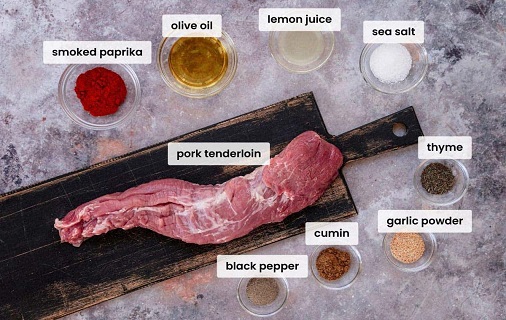
Port Tenderloin Cooking Directions
Ready the Pork: Apply butter or olive oil to the pork tenderloin. Add a little minced garlic, salt, pepper, and Italian seasoning on top.
Spice It Up: For added taste, sprinkle on some chili powder and smoky paprika.
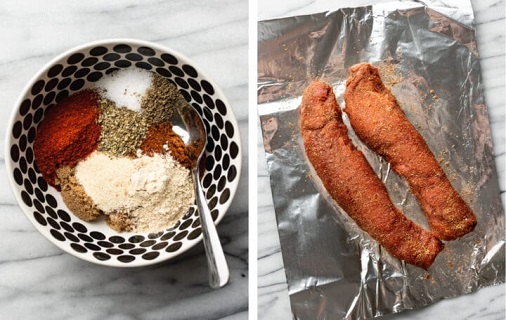
Set the oven temperature to 375°F. Put the pork on a tray or baking dish.
Bake the pork for 20 to 25 minutes, or until it’s juicy and cooked through. Verify whether the meat is done by ensuring the meat thermometer reads 145°F.
Rest and Serve: Just before slicing, let the pork rest for a few minutes. Accompany your preferred sides, such as mashed potatoes or roasted vegetables.
Enjoy Your Meal: Now take a seat, unwind, and enjoy your succulent pork!
Helpful Tips And Tricks
Sear for flavor: Cook the pork tenderloin for a few minutes on each side in a hot skillet before baking. This helps to seal in liquids and produces an outside crust that is delicious. Just be careful that you don’t cook it through in this phase.
For added flavor, marinate the pork tenderloin for several hours, or overnight if you have the time, before cooking. This enhances the meat’s flavor and tenderness by allowing the flavors to seep into it. Combine soy sauce, brown sugar, minced garlic (or garlic powder), vinegar or lemon juice, and a dash of salt and pepper in a bowl. If you have these ingredients, it is highly advised that you proceed with the marinating phase, even if it is optional.
Butter coating: Every ten to fifteen minutes, brush the pork with melted butter while it bakes. This adds moisture and richness to the meat, keeping it juicy and tasty throughout the cooking process.
Keep Relaxed: After baking, allow the pork to rest for at least five to ten minutes on a chopping board before slicing. This makes it possible for the liquids to redistribute, making the finished dish more luscious and tender.
Pair with: Serve your pork tenderloin with a mouthwatering McCormick brown gravy or Au jus sauce to give up the flavor. For more taste and moisture, serve brown gravy alongside. A basic pan sauce consisting of the drippings combined with some wine or broth is consistently delicious.
Reheating: To reheat leftover pork tenderloin, lightly coat the skillet or microwave-safe dish with a little amount of broth or water. This keeps the meat from drying out throughout the reheating process.
Variations And Customizations
Sauces: Try serving your pork tenderloin with a variety of sauces. For a flavor variation, try teriyaki sauce, honey mustard, barbecue sauce, or even a creamy mushroom sauce.
Herb & Spice Blend: Experiment with different herbs and spices to create a unique flavor blend for your pork tenderloin. If you want your own unique taste, you can add dried herbs like thyme, rosemary, or basil and spices like cumin, cinnamon, or smoky paprika.
Makeover of Marinades: Have fun experimenting with the marinade ingredients. Try using balsamic vinegar, orange juice, honey, ginger, or even a drop of your favorite beer or wine for a fresh variation on the classic soy sauce and garlic marinade.
Grill or oven. For a smoky flavor, consider cooking it on the barbecue instead of baking it in the oven. Before baking it, you may alternatively pan-sear it on the stovetop to get a crispy crust.
Wrapping or Stuffing: To add some flair to your pork tenderloin, roll or stuff it with delectable ingredients. For a tasteful presentation, you may roll it with prosciutto, cheese, and herbs or stuff it with ingredients like spinach, feta cheese, and sun-dried tomatoes.
Glaze it Up: To give your pork tenderloin more sweetness and luster, drizzle it with a delicious glaze. For a caramelized finish, brush it with maple syrup, honey, or a brown sugar and mustard mixture before baking.
Pair with a Side Dish: Vary the sides you offer with your pork tenderloin. Try serving it with couscous, quinoa salad, grilled asparagus, or sweet potato fries for a novel and interesting twist on the standard mashed potatoes or roasted vegetables.
Apple Cider Glaze: Combine Dijon mustard, brown sugar, and apple cider to make a sweet and tangy glaze for your pork tenderloin. Pork and this classic taste combination go together like clockwork to create a deliciously festive feast.
For a straightforward meal, consider trying a classic roast pork tenderloin seasoned with garlic, salt, and pepper. Roasting it in the oven produces a rich, soft dish that is both classic and cozy.
Instructions For Storing And Reheating
Storage: After cooking, let the pork tenderloin cool completely.
After the pork tenderloin cools, place it tightly wrapped in aluminum foil or in an airtight container. For up to three or four days, keep it refrigerated.
Heating up: Set your oven to 325°F. Take the pork tenderloin out of the fridge and let it sit for ten to fifteen minutes at room temperature. Keep the pork tenderloin in an oven-safe dish or on a baking sheet. To keep the pork tenderloin from drying out, cover it with aluminum foil.
Bake for ten to fifteen minutes, or until thoroughly heated, in a preheated oven. When heated through, take off the foil and bake for a further five minutes if you want the outside to go crispy.
Serving Suggestions
- Roasted asparagus and mushrooms accompany the pork tenderloin as a flavorful and nutritious side dish.
- Serve Knorr Spinach Dip alongside pork tenderloin for a delicious and simple side dish. The pleasantly savory, creamy spinach dip perfectly complements the delicate pork.
- The juicy pork tenderloin and the smoky flavor of the grilled vegetables combine to make a tasty and wholesome supper. Vegetables grill quickly and easily, making them a great side dish for any occasion.
- Pork tenderloin goes incredibly well with creamy mashed potatoes. The potatoes enhance the delicate meat with their richness.
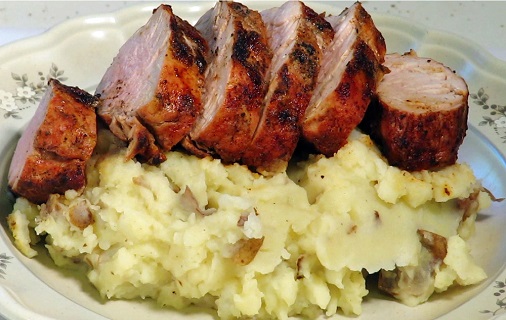
- A tasty dish to pair with pork tenderloin is a green bean and corn casserole. The creamy texture of the dish and the sweetness of the corn wonderfully complement the delicate pork. It’s a simple and filling side dish that gives your dinner table a taste boost. Have fun!
- The dish features pork tenderloin served with pesto green beans.
The crunchy potato wedges are the perfect side dish for the - succulent pork tenderloin, as the savory Parmesan cheese gives them a wonderful depth of flavor. Serve the pork with these Parmesan potato wedges for a satisfying and filling dinner that will not disappoint!
Frequently Asked Questions
Which way of cooking pork tenderloin is the best?
Oven roasting is the ideal way to prepare pork tenderloin. Set the oven to 375°F, sprinkle the pork with herbs and spices, and put it in a roasting pan or on a baking sheet. Roast until the pork reaches an internal temperature of 145°F, about 25 to 30 minutes. Before slicing and serving, give it a few minutes of rest. Every time, roasting guarantees uniform cooking and produces a succulent, juicy pork tenderloin!
Is it better to cook pork tenderloin quickly or slowly?
It is advisable to cook pork tenderloin quickly and at a moderate temperature. This guarantees that it cooks through evenly while retaining its softness and juiciness. Cooking it too quickly can produce a rough exterior, while cooking it too slowly can result in overcooking and a dry texture. For best results, roast the pork tenderloin until the internal temperature reaches 145°F.
Why is my pork tenderloin tough?
There are several reasons your pork tenderloin might be hard. Overcooking is one common cause, as it can make the meat tough and dry. Not allowing pork to rest after cooking, which permits the liquids to re-distribute and maintain the meat’s moisture content, may also be a contributing factor. Improper marinating or seasoning can also result in tough and flavorless pork tenderloin. Cook the pork tenderloin to the proper internal temperature, allow it to rest before slicing, and think about marinating it in advance for more taste and moisture to guarantee a soft cut.
How can I determine the doneness of pork tenderloin?
Use a meat thermometer to measure the internal temperature. When the internal temperature of pork tenderloin hits 145°F, it is safe to consume. Another way to test for doneness is to cut a slice across the thickest area of the tenderloin; the meat should no longer be pink, and the juices should run clear. The basic time for baking is about 25 minutes.
Is cooked pork tenderloin freezer-friendly?
You can store cooked pork tenderloin in the freezer for later use. After letting the cooked tenderloin cool fully, wrap it firmly in aluminum foil or plastic wrap and store it in a freezer-safe container or a plastic bag. You can keep it in the freezer for three to four months.
Does pork tenderloin marinate overnight?
Certainly, marinating tenderloin for the entire night can improve both its flavor and softness. To marinate the pork tenderloin, just prepare your marinade, put the meat in a shallow dish or a plastic bag, cover or seal, and chill overnight.
Should I grill my pork tenderloin rather than bake it?
Without a doubt! A fantastic option is to grill the pork tenderloin. After preheating your grill to medium-high heat, cook the pork tenderloin for 15 to 20 minutes, rotating it once or twice, or until the internal temperature reaches 145°F. Before slicing and serving, allow it to rest for a few minutes.

Pork tenderloin recipe
Equipment
- oven is the main tool for the recipe used for baking pork tenderloin
- 1 Skillet is required for searing the pork
- 1 small bowl for mixing the seasoning blend
Ingredients
- 2 pounds pork tenderloin
- 4 tablespoons butter
- 2 teaspoons Italian seasoning or use a combination of dried oregano, thyme and rosemary
- 1 teaspoon salt
- 1/4 teaspoon ground black pepper
- 1 teaspoon garlic powder
- 1/2 teaspoon smoked paprika
- 1 teaspoon chili powder
Instructions
- Set the oven's temperature to 400°F.
- Season the Pork: In a small bowl, combine the chili powder, smoked paprika, garlic, salt, black pepper, and herbs or Italian seasoning. To coat the pork tenderloin evenly on all sides, rub the spice mixture over its entire surface.
- Cook the Pork: In a sizable oven-safe skillet, heat butter or olive oil over medium-high heat. Add the seasoned pork tenderloin to the skillet after the pan has heated up. Sear the pork until golden brown, about two to three minutes per side.
- Once the pork is seared on all sides, transfer the skillet to the prepared oven. Using a meat thermometer to check for doneness, roast the pork tenderloin for 15to 20 minutes, or until the internal temperature reaches 145°F for medium-rare or 160°F for medium.
- After cooking the pork tenderloin to your preferred doneness, take it out of the oven and let it rest for five to ten minutes on a cutting board before slicing. This guarantees a luscious and tender outcome by allowing the juices to disperse.

